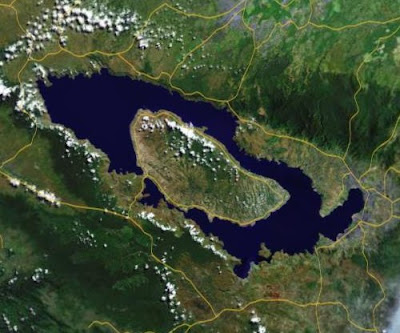LAKE TOBA AND SAMOSIR ISLAND INDONESIA - Lake Toba is a volcanic lake with a length of 100 kilometers and 30 kilometers wide, located in North Sumatra Province, Indonesia. This lake is the largest lake in Indonesia and Southeast Asia. In the middle of this lake there is a volcanic island called the Samosir island. Lake Toba is a volcanic lake that occurs when there is an explosion of the volcano at 73000-75000 years ago, is expected as well as one of the largest volcanic explosions in the world. After the explosion, creating kaledra (depressions in the ground after a volcanic eruption), which was then filled with water and we now know as Lake Toba. The majority ethnic population in the vicinity of Lake Toba is the Batak. In general, the people there livelihood as farmers, traders, and fishermen.
Lake Toba is expected explosion occurred at about 73000-75000 years ago and an eruption (super volcano) the most recent. Bill Rose and Craig Chesner of Michigan Technological University estimate that the volcanic materials spewed out of the mountain as much as 2800 km ³, with 800 km ³ of rock overlies and 2,000 km ³ of volcanic ash which is expected in the wind to the west for 2 weeks. Volcanic dust in the wind has spread to half the earth, from China to South Africa. The explosion occurred during a week and throw the dust up to 10 km above sea level.This incident caused mass death and the extinction of some species also followed. According to some DNA evidence, this eruption also reduced the number of people to about 60% of the total human population of the earth at that time, which is about 60 million people. The eruption also caused the ice age, although experts are still debating.After the eruption, the caldera formed which was then filled with water and became what is now known as Lake Toba.
Upward pressure by magma that has not come out cause the appearance of the island.International multidisciplinary research team, led by Dr. Michael Petraglia, said in a press conference in Oxford, the United States that has found a new archaeological site that is quite spectacular by geologists in the south and north India. At the site revealed how people survive, before and after volcanic eruptions (Supervolcano) in Toba 74,000 years ago, and evidence of life below the ash heap of Mount Toba. Though the source of the eruption within 3,000 miles, from the distribution of ashes.For seven years, experts from Oxford University is researching ecosystem project in India, to look for evidence of life and the lives they left behind equipment in a barren desert. Area with an area of thousands of hectares of this was just the savanna (grassland). While the animal bones were scattered.
The team concluded that a quite large area was covered with dust from this ancient volcanic eruptions.The spread of volcanic dust was very wide, are found almost all over the world. Supervolcano eruption comes from an ancient, namely Mount Toba. Allegations leading to Mount Toba, because it found evidence of molecular forms of volcanic ash in the same 2100 period. Since the caldera crater, now a lake Toba in Indonesia, up to 3000 miles, from the source of the eruption. In fact, surprisingly enough, it turns out that the spread of dust caught up to the North Pole. This is reminiscent of the experts, how powerful the super volcano Toba eruption at the time.
The team concluded that a quite large area was covered with dust from this ancient volcanic eruptions.The spread of volcanic dust was very wide, are found almost all over the world. Supervolcano eruption comes from an ancient, namely Mount Toba. Allegations leading to Mount Toba, because it found evidence of molecular forms of volcanic ash in the same 2100 period. Since the caldera crater, now a lake Toba in Indonesia, up to 3000 miles, from the source of the eruption. In fact, surprisingly enough, it turns out that the spread of dust caught up to the North Pole. This is reminiscent of the experts, how powerful the super volcano Toba eruption at the time.



No comments:
Post a Comment